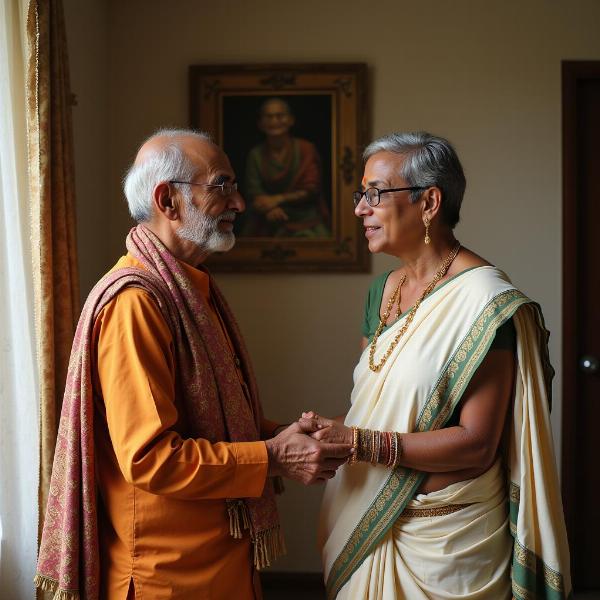Understanding the nuances of “can you show me” in Hindi is crucial for effective communication. Whether you’re asking for directions, seeking a demonstration, or requesting visual aid, knowing the right phrasing can make a difference. This article delves into the various ways to express “can you show me” in Hindi, considering context, politeness levels, and regional variations.
Different Ways to Say “Can You Show Me” in Hindi
The most common and straightforward translation of “can you show me” is “kya aap mujhe dikha sakte hain?” (क्या आप मुझे दिखा सकते हैं?). This phrase is polite and generally suitable for most situations. However, depending on the context and your relationship with the person you’re speaking to, there are other options available.
-
Informal Context: If you’re talking to a friend or family member, you can use a less formal phrase like “dikha sakte ho?” (दिखा सकते हो?) or even “dikhaoge?” (दिखाओगे?). These options are more casual and reflect the closeness of the relationship.
-
Respectful Context: For situations requiring more respect, such as addressing an elder or someone in a position of authority, you might use “kya aap mujhe dikha sakenge?” (क्या आप मुझे दिखा सकेंगे?). This form implies greater deference and politeness.
-
Regional Variations: Just like any language, Hindi has regional variations. In some areas, you might hear phrases like “dekha sakte ho?” (देखा सकते हो?) or “dekhaoge?” (देखाओगे?) which use the verb “dekha” instead of “dikha.” While the core meaning remains the same, these variations reflect the local dialect.
Beyond the Basics: Expressing Specific Requests
“Can you show me” is a broad request. To be more precise, you can add the object you want to see after the verb. For instance:
-
“Can you show me the way to the market?” becomes “Kya aap mujhe bazaar ka raasta dikha sakte hain?” (क्या आप मुझे बाज़ार का रास्ता दिखा सकते हैं?).
-
“Can you show me how to do this?” translates to “Kya aap mujhe yeh kaise karna hai dikha sakte hain?” (क्या आप मुझे यह कैसे करना है दिखा सकते हैं?).
Adding specificity clarifies your request and ensures better understanding.
The Importance of Body Language and Tone
While using the correct Hindi phrase is important, body language and tone also play a significant role. Maintaining eye contact, using a polite tone, and incorporating appropriate gestures can convey respect and sincerity, enhancing the effectiveness of your communication.
Can you show me how to use different politeness levels in Hindi?
Hindi employs different verb conjugations and pronouns to express varying levels of politeness. Mastering these nuances is crucial for navigating social interactions respectfully.
Can you show me examples of regional variations in asking for directions?
Regional dialects often influence how people ask for directions. Understanding these differences can be helpful when traveling within India.
Can you show me common mistakes to avoid when asking for something to be shown?
Being mindful of potential cultural misunderstandings can help you communicate more effectively. For instance, being overly demanding or using an inappropriate tone can be perceived negatively.
 Formal Hindi Conversation
Formal Hindi Conversation
Conclusion
Mastering the various ways to say “can you show me” in Hindi empowers you to communicate effectively in diverse situations. From informal conversations with friends to respectful interactions with elders, choosing the right phrase and tone demonstrates cultural sensitivity and facilitates clear understanding. Remember, combining accurate language with appropriate body language can significantly enhance your communication skills. “Can you show me meaning in Hindi?” Now you know!
FAQ
- How do I ask for directions politely in Hindi? Use “kya aap mujhe raasta dikha sakte hain?” (क्या आप मुझे रास्ता दिखा सकते हैं?) followed by your destination.
- What is the informal way to say “can you show me” in Hindi? You can say “dikha sakte ho?” (दिखा सकते हो?) or “dikhaoge?” (दिखाओगे?) to friends and family.
- Is there a difference between “dikha” and “dekha” in this context? While both mean “to see” or “to show,” “dikha” is more commonly used for “showing” something, while “dekha” is more about “seeing.” Regional variations may use either verb.
- Why is body language important when asking for something to be shown? It conveys respect and sincerity, making your request more effective.
- What are some common mistakes to avoid? Avoid being overly demanding or using an inappropriate tone. Always try to be polite and respectful.
- How can I learn more about regional variations in Hindi? Exploring online resources, interacting with native speakers from different regions, and immersing yourself in Hindi media can help you learn more.
- Where can I get professional Hindi translation services? Meaning-Hindi.in offers expert Hindi translation services for various needs.
Looking for more Hindi language resources? Check out these articles:
- snigdha meaning in hindi
- 10 fruits name in sanskrit and hindi
- account seeded meaning in hindi
- i am not getting you meaning in hindi
Meaning-Hindi.in is your one-stop solution for all your Hindi translation needs. We offer a comprehensive range of services, from business and legal document translation to website localization and technical manuals. Our team of expert translators ensures accurate and culturally sensitive translations, catering to diverse industries and academic fields. Need a quick translation or specialized terminology expertise? Meaning-Hindi.in has you covered. Contact us at [email protected] or call us at +91 11-4502-7584. Let Meaning-Hindi.in bridge the language gap for you!